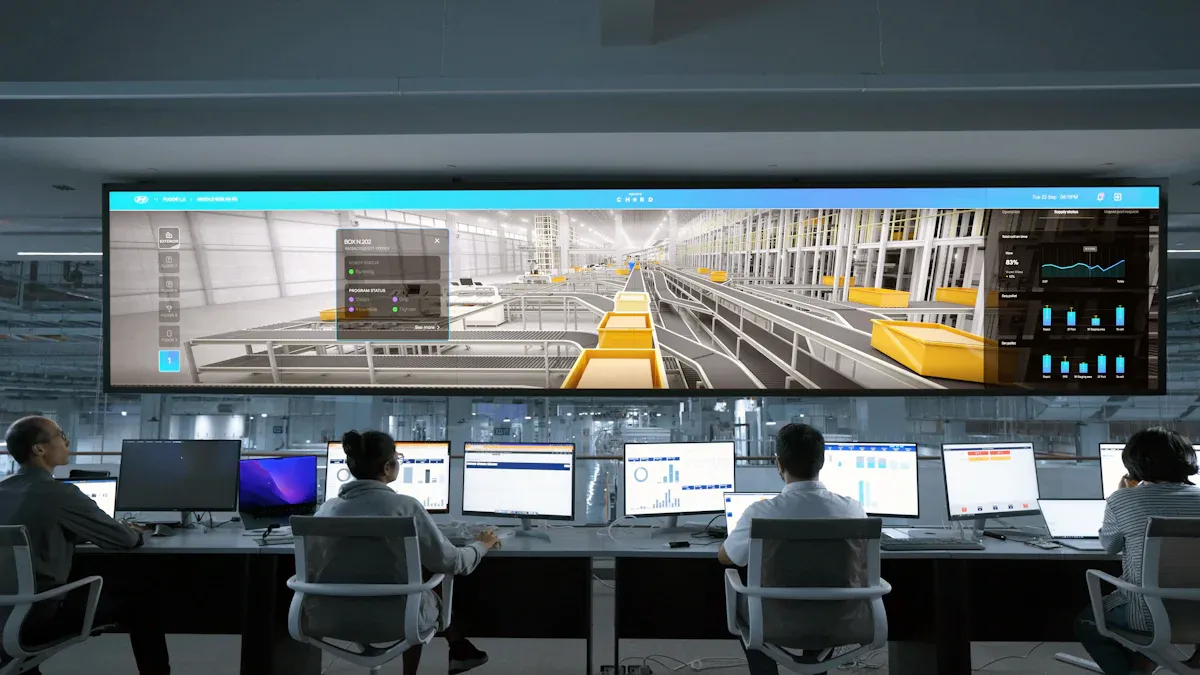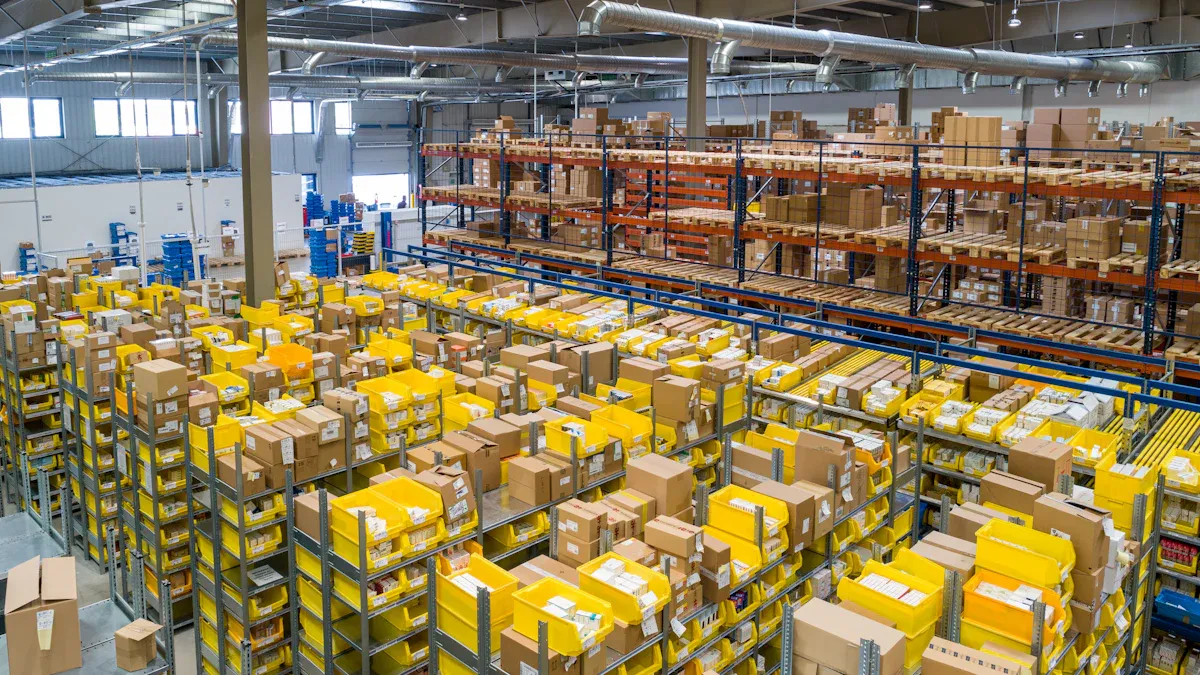A Practical Guide to Beating Integration Challenges in AI Warehouse Automation

Overcoming integration challenges in AI warehouse automation needs a clear plan with steps. Many warehouse managers have trouble making systems work together. Employees often worry about losing their jobs. Recent surveys show that more than half of managers have delays because systems do not work together. Cloud-based warehouse management systems can help work get done faster by over 30%.
Important things to think about are system compatibility, cost control, and training workers. With a good plan, it is possible to make integration work.
Almost 60% of warehouse workers feel unsure about how automation will affect their jobs.
More than half of managers say system incompatibility is a big problem.
Cloud-based solutions make work run 32% better.
Key Takeaways
Integration challenges in AI warehouse automation often come from old systems. Using new tools that work together can make things faster and save money.
Good data is very important for automation to work well. Clean and neat data helps AI give correct answers and makes everything run better.
Training workers is very important. Teaching employees about new technology can help them feel better and work harder in automated places.
Planning costs is very important for automation projects. Knowing how much you need to spend and how much you can save helps you use money wisely.
Getting help from experts can make integration work well. Working with people who know a lot can turn problems into chances to grow.
Key Integration Challenges in Warehouse Automation

Legacy Systems and Compatibility
Many warehouses use old systems. These systems are called legacy systems. They often use old technology. They cannot work well with new AI models. They also do not connect easily with new APIs. This makes it hard to join systems together.
"SAP ECC was never made for fast, big data or built-in AI," says Karyna Mihalevich, Chief Product Officer and AI Ambassador at CLARITY. "Its design makes it tough to run smart, self-learning apps that companies need now."
A company lost a lot of money when its warehouse project failed. The old systems could not give good forecasts. Some common problems are system crashes and unstable systems when adding AI. Legacy systems have trouble growing and handling busy times. These things are important for smooth work and good results.
Data Quality and Silos
Good data is very important in warehouse automation. Bad data can cause wrong guesses and slow work. If inventory data is wrong, there can be stock issues and money loss.
AI needs good data to give helpful advice. Bad data gives wrong ideas and makes customers trust less.
Data silos make joining systems harder. Warehouses spend most of their AI time getting and cleaning data. Old and split-up data often causes problems and failed projects.
Workforce Training and Change
Warehouse automation changes how people do their jobs. Some problems are skill gaps and needing new training.
Robots do the same tasks over and over. People can then solve problems.
Learning new skills is needed to use automated systems.
Good talks help workers see the good side of automation and worry less about losing jobs.
Some companies see less work done when workers do not like change. Workers may go back to old ways if they do not trust new tech. Handling feelings and hopes is important for success.
Cost and Financial Planning
Adding AI to warehouse automation needs careful money planning. The first cost can be high, but automation saves money and time later.
Cost Component | Description |
|---|---|
Hardware | Money for robots, drones, cameras, and sensors for AI. |
Software | Money for AI programs and warehouse systems, often with fees. |
Old system connection | Extra money to join AI with old software or ERPs. |
Training | Money to teach workers to use new AI tools. |
Maintenance | Money for updates, fixing bugs, and keeping systems working. |
Size of the warehouse | Bigger warehouses cost more because they need more devices and automation. |
Overall Cost Range | Small warehouses spend thousands, big ones can spend millions. |
Yearly costs like fixing and software can add up to 15% of the budget. Using AI to guess future needs can help save money and show the value of the first cost. Planning for the future helps warehouses avoid new problems later.
Solutions for Integration with Existing Systems
Choosing Compatible Automation Tools
Picking the right automation tools is the first thing to do. Companies need tools that work with their warehouse management systems. The best tools connect to both old and new systems. This makes it easier to join systems and saves money on custom work.
Criteria | Description |
|---|---|
Integration | The system should link with ERP and other automation tools. |
Implementation and upkeep | Vendors must give clear training and help when needed. |
Scalability | The system should grow with the business and more warehouses. |
User experience | Simple interfaces help workers learn fast. |
Support for automation | The system should work with mobile devices and equipment. |
Some tools are very good at joining with old systems:
ActiveBatch can handle jobs in many places and works with legacy systems.
Logiwa IO connects new and old systems to automate warehouse work.
Companies should pick tools that work well with their warehouse system.
Trying out new tools in steps helps companies check if they fit. This way, they can fix problems before using them everywhere. It also helps work run better.
Ensuring Seamless Data Integration
Data is very important in automated warehouses. To join systems well, companies must keep data clean and neat. Good data helps AI give correct answers and makes automation easier.
Good ways to join data are:
Clean and organize all data before starting automation.
Make sure all systems use the same data format.
Put all warehouse data in one place.
Tip: One main data source helps automated systems find and use information.
Some problems can slow down joining systems. These are mistakes in changing data, different data shapes, and double records. Bad data can make automation less helpful.
Pitfall Description | Example |
|---|---|
Data transformation logic errors | A bad rule can mess up many records. |
Mismatched schemas | Different data shapes can make data get lost. |
Data quality issues | Double records cause mix-ups when joining sources. |
Checking data and knowing where it comes from helps stop these problems. Good data habits help automation work better and make joining systems easier.
Addressing Cybersecurity Risks
Cybersecurity is a big worry in warehouse automation. Many companies have had problems with unsafe APIs. Hackers like to attack systems that talk to the outside. These risks can hurt data and stop work.
Common threats are:
API problems, which have hit over half of companies.
Hackers use weak API keys or bugs to steal data.
Millions of accounts have been exposed because of bad security.
To keep warehouse systems safe, companies should:
Change how much AI can do alone, based on risk.
Add human checks when needed.
Watch and update AI systems often.
Teach workers about security.
Use zero-trust security plans.
Use AI to spot threats early.
Test code for bugs and update software.
Use strong passwords and check who can use the system.
Protect both hardware and software.
Note: A good plan for attacks and cloud backups help companies recover fast.
These actions help stop problems and keep warehouse work safe.
Leveraging Expert Support
Expert helpers can guide companies through joining systems. The right experts help make a good AI plan and match automation to business goals. They know about warehouse simulation, data modeling, design, and automation.
Look for experts who:
Have made AI plans before.
Know how to model data and simulate warehouses.
Understand design and automation technology.
Know about AI and machine learning in warehouses.
Experts also help companies use smart guesses for inventory and routes. This help makes work better and lets companies get more from automation.
Tip: Working with skilled experts can turn hard problems into chances to grow.
By using these solutions, companies can join systems well and get the most from automated warehouses.
Step-by-Step Warehouse Automation Roadmap

Assess Current Systems
Warehouse managers start by checking their systems. They look at technology, order numbers, workers, mistakes, safety, and money. The table below shows what they check:
Criteria | Description |
|---|---|
Technology | Check if WMS/WES systems can use API or middleware. |
Volume | See if order numbers stay the same or change a lot. |
Labor | Think about how worker shortages or quitting affect work. |
Accuracy | Look for picking and packing mistakes that cost money. |
Safety | Find places where workers get hurt or bump into things. |
ROI Potential | Decide if automation saves money or makes service better. |
Managers pick three areas to try first. They choose places with the most good and least trouble. Manual picking, packing, and busy lanes are good places to start.
Set Integration Goals
Setting goals helps teams beat integration problems. They begin by checking how well things work. They use numbers like order accuracy and worker speed. Teams match goals to business plans, like growing bigger or making customers happy. They use new tech to grow and care about the planet.
Begin with a performance check.
Match goals to business plans.
Care about the environment.
Pilot and Test Solutions
Teams try new ideas before using them everywhere. They check the warehouse for slow or mistake-prone jobs. Clear goals help them pick what to fix. They pick automation for now and for later. Training workers and helping them change is important. Connecting with ERP and supply chain systems keeps things smooth. Watching key numbers helps teams change fast.
Check warehouse jobs.
Set goals for money and work.
Pick automation for now and later.
Teach workers and help them change.
Connect with ERP and supply chain.
Watch important numbers all the time.
Trying new things first helps before using them everywhere. Warehouses that use AI well work better and solve problems.
Monitor and Optimize
After using automated systems, teams watch and improve them. AI helps see every step of the process. IoT and wearables check worker health and safety. Smart safety tools look at data and what is happening now. Warehouses watch order speed and worker output right away. These ways help teams fix problems and join systems better.
Tip: Watching and improving all the time turns small wins into big, lasting results.
Real-World Integration Success Stories
Overcoming Legacy Barriers
Many companies have trouble when they add new tech to old systems. Barrett Distribution used Gather AI and saved more than $250,000. They got their money back in less than a year. Sienzi Logistics in Turkey used Kairos Logic’s AI with their ERP system. They used an API so both systems could share information. This made picking routes better and work faster.
Barrett Distribution saved money and worked faster.
Sienzi Logistics used APIs to join old and new systems.
APIs help companies fix system integration problems.
It is hard to add AI to legacy systems. Companies can use APIs and good planning to connect old and new tech.
Achieving Data Harmony
Warehouses need clean and neat data for automation to work. Many companies use easy ways to fix data problems. The table below shows some ways to make data better.
Strategy | Description |
|---|---|
Define naming conventions | Use the same names and formats to stop mix-ups. |
Apply transformation rules | Change data to match, like changing time or money units. |
Integrate via APIs or Data Lakes | Connect systems and keep all data together. |
Implement Data Governance | Give people jobs to watch data and track changes. |
Prepare for AI Use | Make sure data is ready and simple for AI to use. |
These ways help companies fix data silos and make automation easier. Good data habits give better results and fewer problems.
Empowering Teams
Companies do better when workers learn new skills and use automation. The table below shows how helping workers makes automation work.
Evidence | Description |
|---|---|
Engaging Workforce | Training and clear talks help workers like new tech. |
Technology Champion Roles | Workers who lead and share ideas make joining systems easier. |
Employee Perspective | Workers who see automation as good will support it more. |
Integration of Technology | Automation does easy jobs, so workers solve harder problems. |
Resilient Workflows | Tech does simple tasks, and skilled workers handle special cases. |
Impact on Workforce Development | Automation helps workers learn and grow in their jobs. |
Focus on Critical Tasks | Workers move from manual work to running automated systems. |
Training and Engagement | Good training makes workers happier and stay longer. |
Helping teams gives companies more from warehouse automation. Training and support make joining systems easier and help workers do well.
Warehouse managers can solve integration problems with a step-by-step plan. They look at their systems, make goals, try out ideas, and keep making things better. Real-life stories show these steps work well:
Amazon got 50% more work done and saved 30% using AI and robots.
Modular solutions help warehouses change when the market changes.
Smart software and working together stop vendor lock-in.
A clear plan makes joining systems easier. Teams should begin soon and keep improving for long-term success.
FAQ
What is the biggest challenge in AI warehouse integration?
Legacy systems are the hardest part. They use old technology. This old tech does not work with new AI tools. Warehouses need special ways to connect old and new systems.
How can companies improve data quality for automation?
Companies clean and sort data first. They use one main data source. They make rules for names and formats. Good habits help AI give better answers.
Does automation replace warehouse workers?
Automation does easy and repeated jobs. Workers solve problems and run systems. Training helps teams learn new skills and handle changes.
How do companies manage costs during automation projects?
Companies plan money for hardware, software, training, and fixing things. They start with small test projects. Smart planning saves money and stops surprises.
See Also
The Future of Retail Lies in AI-Driven Stores
Understanding the Growth of AI-Enhanced Corner Shops
Transforming Online Retail Management with AI Solutions
Launching a Low-Cost AI-Driven Corner Store Successfully
Modern Retail Advantages of AI-Enhanced Combo Vending Machines
